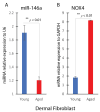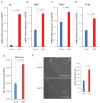miR-146a Decreases Inflammation and ROS Production in Aged Dermal Fibroblasts
- PMID: 38999931
- PMCID: PMC11241687
- DOI: 10.3390/ijms25136821
miR-146a Decreases Inflammation and ROS Production in Aged Dermal Fibroblasts
Abstract
Aging is associated with a decline in the functionality of various cell types, including dermal fibroblasts, which play a crucial role in maintaining skin homeostasis and wound healing. Chronic inflammation and increased reactive oxygen species (ROS) production are hallmark features of aging, contributing to impaired wound healing. MicroRNA-146a (miR-146a) has been implicated as a critical regulator of inflammation and oxidative stress in different cell types, yet its role in aged dermal fibroblasts and its potential relevance to wound healing remains poorly understood. We hypothesize that miR-146a is differentially expressed in aged dermal fibroblasts and that overexpression of miR-146a will decrease aging-induced inflammatory responses and ROS production. Primary dermal fibroblasts were isolated from the skin of 17-week-old (young) and 88-week-old (aged) mice. Overexpression of miR-146a was achieved through miR-146a mimic transfection. ROS were detected using a reliable fluorogenic marker, 2,7-dichlorofluorescin diacetate. Real-time PCR was used to quantify relative gene expression. Our investigation revealed a significant reduction in miR-146a expression in aged dermal fibroblasts compared to their younger counterparts. Moreover, aged dermal fibroblasts exhibited heightened levels of inflammatory responses and increased ROS production. Importantly, the overexpression of miR-146a through miR-146a mimic transfection led to a substantial reduction in inflammatory responses through modulation of the NF-kB pathway in aged dermal fibroblasts. Additionally, the overexpression of miR-146a led to a substantial decrease in ROS production, achieved through the downregulation of NOX4 expression in aged dermal fibroblasts. These findings underscore the pivotal role of miR-146a in mitigating both inflammatory responses and ROS production in aged dermal fibroblasts, highlighting its potential as a therapeutic target for addressing age-related skin wound healing.
Keywords: aging wound healing; dermal fibroblasts; miR-146a; reactive oxygen species (ROS).
Conflict of interest statement
The authors declare no conflicts of interest.
Figures





Similar articles
-
LincRNA-EPS Promotes Proliferation of Aged Dermal Fibroblast by Inducing CCND1.Int J Mol Sci. 2024 Jul 12;25(14):7677. doi: 10.3390/ijms25147677. Int J Mol Sci. 2024. PMID: 39062918 Free PMC article.
-
miRNA-146a Mimic Inhibits NOX4/P38 Signalling to Ameliorate Mouse Myocardial Ischaemia Reperfusion (I/R) Injury.Oxid Med Cell Longev. 2021 Jul 27;2021:6366254. doi: 10.1155/2021/6366254. eCollection 2021. Oxid Med Cell Longev. 2021. PMID: 34367463 Free PMC article.
-
MicroRNA-146a Deficiency Delays Wound Healing in Normal and Diabetic Mice.Adv Wound Care (New Rochelle). 2022 Jan;11(1):19-27. doi: 10.1089/wound.2020.1165. Epub 2021 Jul 2. Adv Wound Care (New Rochelle). 2022. PMID: 33554730 Free PMC article.
-
miR-21 Expressed by Dermal Fibroblasts Enhances Skin Wound Healing Through the Regulation of Inflammatory Cytokine Expression.Inflammation. 2024 Apr;47(2):572-590. doi: 10.1007/s10753-023-01930-2. Epub 2023 Dec 2. Inflammation. 2024. PMID: 38041730
-
MitomiRs in human inflamm-aging: a hypothesis involving miR-181a, miR-34a and miR-146a.Exp Gerontol. 2014 Aug;56:154-63. doi: 10.1016/j.exger.2014.03.002. Epub 2014 Mar 7. Exp Gerontol. 2014. PMID: 24607549 Review.
Cited by
-
MicroRNAs in the Mitochondria-Telomere Axis: Novel Insights into Cancer Development and Potential Therapeutic Targets.Genes (Basel). 2025 Feb 25;16(3):268. doi: 10.3390/genes16030268. Genes (Basel). 2025. PMID: 40149420 Free PMC article. Review.
-
LincRNA-EPS Promotes Proliferation of Aged Dermal Fibroblast by Inducing CCND1.Int J Mol Sci. 2024 Jul 12;25(14):7677. doi: 10.3390/ijms25147677. Int J Mol Sci. 2024. PMID: 39062918 Free PMC article.
-
miRNAs and their multifaceted role in cutaneous wound healing.Funct Integr Genomics. 2025 Feb 4;25(1):33. doi: 10.1007/s10142-025-01535-y. Funct Integr Genomics. 2025. PMID: 39903291 Review.
-
Connecting the Dots: How MicroRNAs Link Asthma and Atherosclerosis.Int J Mol Sci. 2025 Apr 10;26(8):3570. doi: 10.3390/ijms26083570. Int J Mol Sci. 2025. PMID: 40332077 Free PMC article. Review.
References
-
- Bickers D.R., Lim H.W., Margolis D., Weinstock M.A., Goodman C., Faulkner E., Gould C., Gemmen E., Dall T. The burden of skin diseases: 2004: A joint project of the American Academy of Dermatology Association and the Society for Investigative Dermatology. J. Am. Acad. Dermatol. 2006;55:490–500. doi: 10.1016/j.jaad.2006.05.048. - DOI - PubMed
MeSH terms
Substances
Grants and funding
LinkOut - more resources
Full Text Sources

